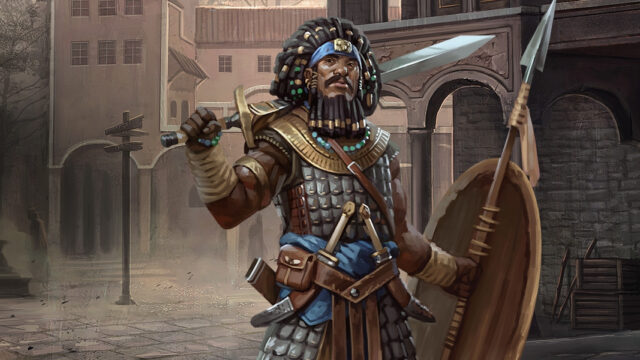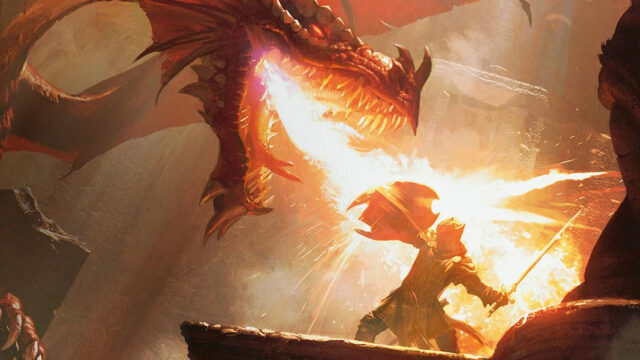Fighters are a classic Dungeons & Dragons class. They are the warriors and knights who charge headfirst into battle, the ones who rely on their body and their physical strength to survive whatever the world throws at them.
While Fighters are often stereotyped as a simple melee class, the Fighter in D&D 5th edition is highly versatile. The abilities you select can lead your Fighter down many different paths, from a brawny tank that can dive straight into battle to a magical warrior that can cast spells mid-fight. From a jack of all trades to a focused powerhouse, Fighters are overflowing with potential.
Want to learn more before your first campaign? Here’s how to get started playing as a Fighter in Dungeons & Dragons 5E.
Choosing your Fighting Style and Martial Archetype
How you play your Fighter will depend a lot on two elements: The Fighting Style you choose at your first level and the Martial Archetype you choose at third level. Both of these decisions affect the abilities you are given and thus allow you to fill different roles within a group.
If pure damage is your thing, try combining the “Dueling” Fighting Style with the “Champion” Martial Archetype. This combination grants Fighters two bonus damage when wielding a single weapon. Then at level three, you’ll get the “Improved Critical” ability that lets you score a critical hit on a roll of 19 or 20, massively increasing your chance to land a devastating blow.
However, if you’re looking to make your Fighter provide some party buffs, try taking the “Protection” Fighting Style and combine that with the “Battle Master” Martial Archetype. When you hit level three, you’ll be able to make your allies harder to hit. Maneuvers given by the “Combat Superiority” trait also boost your allies’ attack power, making your Fighter double as a support class in all but name.
If you feel like adding some magic to your arsenal, then try the “Eldritch Knight” Martial Archetype. This gives you access to several spells, as well as the ability to bond with your weapon, allowing you to summon it in the blink of an eye. It’s pretty useful for both D&D combat, as well as roleplaying opportunities off the battlefield.
How to play a Fighter

Like all D&D classes, a lot of your roleplay will be informed by what background you take and what sort of character you feel comfortable playing. When it comes to character development, don’t feel limited by the Fighter’s stereotypical brawn. Your Fighter can be anything and anyone, from shy to extroverted, bookish to boorish.
During combat, move into positions where you can damage opponents, protect other party members, and keep enemies out of attack range from your allies. This is especially true if your party has spellcasters, who traditionally have low health and need to avoid damage to cast spells with a concentration requirement.
If you’re using the Eldritch Knight Martial Archetype, you’ll also have to keep in mind which spells require concentration. If you want to maintain one of these spells, you’ll have to find a way to get out of the fray to prevent your magic from being interrupted.
While you can take more damage than other classes, you aren’t invincible. At early levels, your small health pool means that it will only take a few lucky hits to bring you down. Try to avoid getting surrounded. Remember that retreating is always an option. If you don’t think you can overcome the odds in front of you, using a Disengage action to get to a safe location is always a viable strategy.
Always play to your strengths, especially at early levels where every bonus counts. For instance, if you take the “Archery” Fighting Style, try to avoid using melee weapons if at all possible to make sure you get your bonus on every single attack.
Using Action Surge and Second Wind

Fighters get “Second Wind” at first level and “Action Surge” at second level. Second Wind allows you to quickly heal once per rest, something that will come in handy if you get swarmed with foes.
Action Surge allows you to make an additional action once per rest. This can be used in many different ways, depending on the situation you’re dealing with. If you think a creature is dangerous but has low health, you can use Action Surge to attack twice. If you believe a foe is strong at close range, you could use your Action Surge to make a bonus Dash action, allowing you to strike them and then quickly get out of attack range.
The Fighter is a very versatile class that, with the right choices, can play many roles in a group. As you play, you’ll fall into a playstyle that fits you, your character, and your group, and you’ll find new and creative ways to combine your abilities and actions—as well as gain new ones as you level up.
-----------------------
By: Jonathon Greenall
Title: How To Play The Fighter Class In Dungeons & Dragons 5E
Sourced From: wegotthiscovered.com/gaming/how-to-play-the-fighter-class-in-dungeons-and-dragons-5e/
Published Date: Mon, 19 Jul 2021 14:15:55 +0000
Did you miss our previous article...
https://ballerawards.news/movies/2021-shows-that-proved-the-weekly-release-schedule-is-still-best






